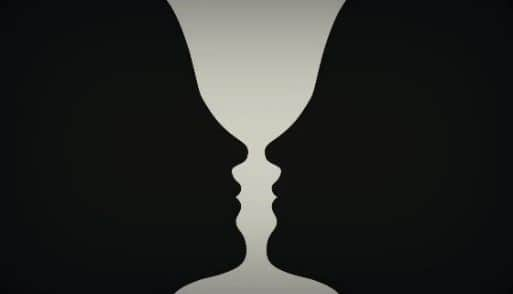What do you see in this optical illusion? Image you see first shows your dominant personality traits
and live on Freeview channel 276
Optical illusions are intriguing things that can play curious tricks on our brain.
The same image can be interpreted in different ways and how we perceive optical illusions is thought to reveal which side of our brain is more dominant.
Advertisement
Hide AdAdvertisement
Hide AdIt is said that whether we favour the left or right side of our brain can influence what personality traits we are most likely to have.
As such, how you see an image could suggest whether you are more likely to be extroverted or introverted.
What do you see in this optical illusion?
A clever optical illusion shared on social media can be seen in two different ways.


Some viewers will see an image of a white goblet against a black background first, while others will see the outline of two faces looking at each other against a white background first.
Advertisement
Hide AdAdvertisement
Hide AdIt is claimed that the image you spot first says a lot about your dominant personality traits.
In a video posted on TikTok, a voiceover explains: “If the first thing that caught your eye was a goblet, you’re a reserved and calm person.
"You don’t need external sources of energy and motivation; you’re fine in your own thoughts and world.
“However, you tend to worry about minor details, which can stop you from seeing the picture.”
Advertisement
Hide AdAdvertisement
Hide AdBy comparison, those who saw an image of two people facing each other first are said to be more likely to be extroverted.
The video states: “You prefer to spend time among people, which is why it’s so important to surround yourself with those who support you and bring positive energy to your life.
“You see the grand scheme of things and don’t get caught up in the little stuff.”
TikTok users reacted to the video and discussed how accurate the descriptions were.
Advertisement
Hide AdAdvertisement
Hide AdOne user said: “The goblet explanation couldn’t describe me better.”
However, other users who saw the goblet said the description didn’t match up to their personality.
“So wrong. I saw two faces first, I hate going out and choose not to talk to people and like to be at peace alone with myself,” one user said.
Another agreed: “Nope I saw the people but I like to stay home.”
Advertisement
Hide AdAdvertisement
Hide Ad“I saw the faces first. I’m a total introvert,” a user said.
“I saw 2 ppl, but I’m not a social person”, added another.
Some users also noted that they could see both the goblet and the faces at the same time.
One user said: “I saw the goblet and the two people immediately. So....I am a God.”
“I always see both the goblet and two people,” said another.
Advertisement
Hide AdAdvertisement
Hide Ad“My eyes/brain will not pick just one, both introvert and extrovert tendencies/traits apply to me also,” a third commented.
How do the left and right sides of the brain differ?
The left side of the brain is more verbal, analytical and orderly than the right, and is better at tasks such as reading and writing.
The right side of the brain is said to be more visual and intuitive, and is often described as being more “creative”.
It is thought that the more dominant side of our brain can influence what our personality is like, such as whether we are more outgoing, extroverted, creative or analytical.
Advertisement
Hide AdAdvertisement
Hide AdThe theory about optical illusions revealing which side of our brain is more dominant came about in the 1960s thanks to psychobiologist and Nobel Prize winner Roger W Sperry.
However, a two year analysis recently found that there was no proof that this theory was actually true.
The research, published in 2013, said: “It has been conjectured that individuals may be left-brain dominant or right-brain dominant based on personality and cognitive style, but neuroimaging data has not provided clear evidence whether such phenotypic differences in the strength of left-dominant or right-dominant networks exist.
“Lateralization of brain connections appears to be a local rather than global property of brain networks, and our data are not consistent with a whole-brain phenotype of greater “left-brained” or greater “right-brained” network strength across individuals.”
Want more visual magic? Check out more mind-bending optical illusions.
Comment Guidelines
National World encourages reader discussion on our stories. User feedback, insights and back-and-forth exchanges add a rich layer of context to reporting. Please review our Community Guidelines before commenting.
